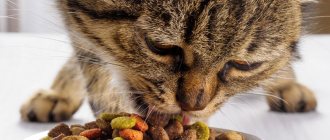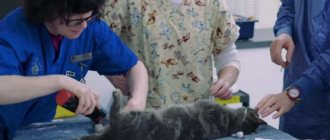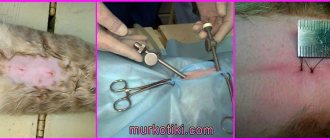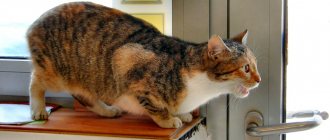Do I need to spay or neuter my male cat?
It seems that everything is obvious: you do not plan to breed purebred kittens - is this not a sufficient reason to castrate or sterilize the cat?
But in reality, spaying and neutering have other advantages. After surgery, your pet will be calmer and less stressed. Spayed/neutered pets no longer need to defend their territory with their relatives and search for partners, which means they are freed from the risk of injury, and you, as the owner, no longer have to look for your pet. The cat stops experiencing significant hormonal changes and anxiety that accompany “estrus”, and becomes calmer and more affectionate.
How will surgery affect my cat's health?
If we talk about the advantages of sterilization and castration, veterinary experts note that castrated cats live longer. They are less likely to come into conflict with other animals, which reduces the likelihood of injuries acquired in a fight with an opponent or from a fall from a height.
But at the same time, changes occur in the pet’s body that deserve special attention from the cat owner: a decrease in metabolic rate and motor activity, which occurs against the background of a decrease in the production of sex hormones.
Together, these factors can lead to the pet gaining weight, which will provoke metabolic disorders and the development of urolithiasis (KD) and diabetes. Special nutrition will help prevent such complications.
If you decide to get a kitten, do not forget the following
It's no secret that many people simply dote on their little furballs. They give us joy every day. When the kitten starts living in the house, everyone is just happy. However, only six months pass and serious problems begin. Until recently, a kitten was a small and cute creature, but now it has turned into an adult cat who makes noise at night and constantly runs away from the house in search of cats. You can't go against nature! In this case we are talking about instincts. They are the ones who force the animal to mark its territory.
Experienced housewives know how difficult it is to remove cat smell from an apartment or rid shoes of it. It is important to note that a city apartment is not a natural habitat for cats. Mother Nature has something completely different in mind for these animals. Nature requires cats to mate with cats about eight times a year. Hormones are constantly being produced, which have a powerful effect on the behavior of the animal. He marks and defends his territory, makes noise and screams at night - this is absolutely normal for him. The point is that in their natural environment, cats have no barriers to following their instincts. When your cat starts acting this way in your home, your life can become truly uncomfortable. That is why it is important to take all necessary measures in advance - take care of castration of the cat or sterilization of the cat.
Most owners do not want their cats to have offspring regularly, and the cats are away from home for several weeks and leave foul-smelling marks in the apartment. Because of this, tailed pets of both sexes are castrated by removing their gonads. In females these glands are the ovaries, and in males the testes. Since the latter are located outside, male castration is a relatively simple and therefore less expensive operation than male castration. For the same reason, cats recover from it faster. Within a day after castration, your cat will again be able to vigorously jump around the apartment, while the cat will need several days of rest.
What should a sterilized cat eat?
- In the matter of controlling the pet’s weight, and therefore in preventing the development of diabetes in a cat, the owner will be helped by special diets that take into account the special energy needs of sterilized pets.
For example, the precisely balanced diet of Hill's™ Science Plan™ Sterilized Cat contains the “Weight Control Formula”, if the recommended feeding standards are followed, the pet can receive exactly as much energy as it can expend in a day. At the same time, the “Weight Control Formula” will take care of maintaining the cat’s muscle mass.
- Excess weight, imbalance of microelements and acidification of urine are the basis for the development of diseases of the lower urinary tract. These risks are also addressed in Hill's™ Science Plan™ Sterilized Cat Diet, which contains precisely balanced levels of phosphorus and magnesium to help prevent stone formation and inflammation in the urinary system.
- To ensure your pet is eating nutritiously while still enjoying the meal, offer a variety of Hill's™ Science Plan™ Sterilized Cat wet diets with chicken, salmon, trout and turkey as treats.
- Proper nutrition for spayed and neutered cats must also be appropriate for their age, so Hill's™ Science Plan™ Sterilized Cat diets include a diet for pets over seven years of age.
Cat sterilization - what is it?
Neutering of cats and dogs is a simplified name for the removal of the ovaries ( oophorectomy ) or removal of the uterus and ovaries ( ovariohysterectomy ). In veterinary medicine, sterilization of cats is very common. Many owners subject their pets to this type of surgery.
According to veterinarians, the optimal solution is to simultaneously perform an oophorectomy along with a hysterectomy.
To the list of advantages
(relative indications) sterilization of cats includes:
- the ability to avoid unwanted cat pregnancy;
- the ability to avoid behavior that is associated with estrus;
- prevention of the development of breast tumors.
Absolute readings:
- purulent inflammation of the uterus (Pyometra);
- tumors of the uterus and ovaries.
It is not recommended to sterilize cats during the period of estrus, since at this time there is swelling and congestion of the uterus.
Surgery to sterilize a cat or dog - detailed description
Preparing for surgery - tips for owners
It is recommended that the cat's intestines and stomach be empty during surgery. To do this, a day before surgery, the cat should be given a tablespoon of Vaseline oil. This is perfect as a laxative.
Immediately before the operation, a 12-14-hour fasting diet is maintained, and water is removed from the cat’s diet 1 hour before the operation.
It is also recommended to purchase two postoperative blankets in advance. It is necessary to hem each ribbon of the blanket. This is done so that after the operation the cat does not pull the thread out of the ribbon and swallow it when licking it. Try the blanket on your cat before surgery. Practicing putting on a blanket will not hurt you. You will also find out how the cat reacts to this. In most cases, animals do not like the blanket and behave very tightly in it.
Progress of the operation itself
Cats are sterilized under general anesthesia. Anesthesia is administered intravenously or intramuscularly. Remember that a cat is anesthetized with its eyes open, which is why a special ointment is applied to the cornea to protect it from drying out. The owner does not need to know all the stages of the cat sterilization operation, but it is still advisable to learn the main stages.
Doctors perform surgical access along the white (midline) line of the abdomen. Using this technique, it is possible to remove uterine tissue in all cases, therefore eliminating the risk of further development of pyometra of the uterine stump.
Removal of the ovaries is one of the most important stages of the operation. All ovarian tissue is removed to prevent the animal from going into heat. The uterus is excised completely below the division into two horns (bifurcation).
Caring for a cat after sterilization surgery - features of care
The animal is brought out of anesthesia with the help of special drugs and a dropper. Soon all his reflexes are restored, except for coordination of movement. It will become normal only after 24 hours after the anesthesia wears off. Until this time, it is better to make a warm bedding on the floor, since after amnesia the animal’s temperature immediately drops by 2-3 degrees. You can also cover the cat with a warm blanket or attach a warm heating pad to its back.
Remember that swallowing and bowel function may not return to normal immediately.
If your pet has a dry mouth after surgery, you can moisten it with water from time to time. After five hours, place a bowl of water for him. Your pet should receive the first portion of food only a day after the operation. It is best to give 1/3 of the usual diet. In the first days after surgery, try to feed soft foods. It is also possible that your cat's appetite will not be the best for the first few days.
The cat is also given an injectable antibiotic after surgery. Doctors use a long-acting drug. You will have to give two subcutaneous injections yourself. In addition, you will have to clean the stitches on your cat once a day with alcohol.
Usually the sutures are removed on the 10th -12th day after surgery. Before removing them, make sure that the cat is always wearing a blanket. Change the blanket as soon as it becomes dirty. It is best to buy two blankets at once. This way you can wash them one at a time.
Typically, immediately after surgery, the cat's appetite increases and metabolism decreases. This can cause obesity. Be sure to monitor your pet's diet.
How will a cat's character change after castration or sterilization?
After the operation, cats no longer experience anxiety and stress caused by sexual desire. They become calmer and more affectionate, and show greater interest in relationships with the owner.
However, there is an opinion that spayed or neutered pets “revenge” the operation by forgetting how to use the litter box. This assumption is incorrect. Most often, the reason lies in improper upbringing or lack of attention to the pet, which awakens resentment and jealousy in the cat.
Also, such manifestations may be symptoms of certain disorders of the digestive tract, urinary system and other diseases, so it is better for vigilant and loving owners to once again consult a specialist.
Castration and sterilization have their pros and cons. But in reality, no matter what you choose, the health and condition of your pet largely depends on how correctly and consistently you care for it.
Useful articles, expert advice and competitions for caring owners can be found in the Hill's Club. Join us!
Complications after castration
Even if castration was performed in a good clinic, there is a risk of complications. The main ones include:
- Bleeding from the scrotum, vas deferens, vessels of the spermatic cord. If a vein or artery has been damaged, blood may flow in a small or powerful stream. In this case, the doctor finds the injured vessel, sutures it or applies a ligature.
- Scrotal swelling. It develops when dirt gets into the wound, as a result of tissue separation due to improper movement of the scalpel, during surgery in a dusty room. To eliminate swelling, the doctor prescribes systemic antibiotics.
- Loss of tissue - the stump of the spermatic cord, a section of the intestine, the omentum. It occurs if the cat has an enlarged inguinal ring, or it was damaged as a result of strong compression of the abdomen during surgery, due to an incorrect incision of the scrotum. It can only be treated surgically.
Properly performed castration does not deprive the pet of the joys of life. On the contrary, after such an operation the risk of developing urolithiasis, which occurs due to hormonal disorders, is reduced.
All information posted on the site is provided in accordance with the User Agreement and is not a direct instruction to action. We strongly recommend that before using any product, you must obtain a face-to-face consultation at an accredited veterinary clinic.











